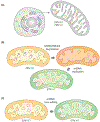Mitochondrial genome engineering coming-of-age
- PMID: 35599021
- PMCID: PMC9283244
- DOI: 10.1016/j.tig.2022.04.011
Mitochondrial genome engineering coming-of-age
Erratum in
-
Mitochondrial genome engineering coming-of-age: (Trends in Genetics, 38:869-880, 2022).Trends Genet. 2023 Jan;39(1):89. doi: 10.1016/j.tig.2022.08.002. Epub 2022 Aug 26. Trends Genet. 2023. PMID: 36038406 No abstract available.
Abstract
The mitochondrial genome has been difficult to manipulate because it is shielded by the organelle double membranes, preventing efficient nucleic acid entry. Moreover, mitochondrial DNA (mtDNA) recombination is not a robust system in most species. This limitation has forced investigators to rely on naturally occurring alterations to study both mitochondrial function and pathobiology. Because most pathogenic mtDNA mutations are heteroplasmic, the development of specific nucleases has allowed us to selectively eliminate mutant species. Several 'protein only' gene-editing platforms have been successfully used for this purpose. More recently, a DNA double-strand cytidine deaminase has been identified and adapted to edit mtDNA. This enzyme was also used as a component to adapt a DNA single-strand deoxyadenosine deaminase to mtDNA editing. These are major advances in our ability to precisely alter the mtDNA in animal cells.
Keywords: TALEN; gene editing; genetic engineering; mitochondria.
Copyright © 2022 Elsevier Ltd. All rights reserved.
Figures


References
-
- Anderson S, et al., Sequence and organization of the human mitochondrial genome. Nature, 1981. 290(5806): p. 457–65. - PubMed
-
- Moraes CT, What regulates mitochondrial DNA copy number in animal cells? Trends Genet, 2001. 17(4): p. 199–205. - PubMed
-
- Srivastava S and Moraes CT, Manipulating mitochondrial DNA heteroplasmy by a mitochondrially targeted restriction endonuclease. Hum Mol Genet, 2001. 10(26): p. 3093–9. - PubMed
Publication types
MeSH terms
Substances
Grants and funding
LinkOut - more resources
Full Text Sources
Other Literature Sources

